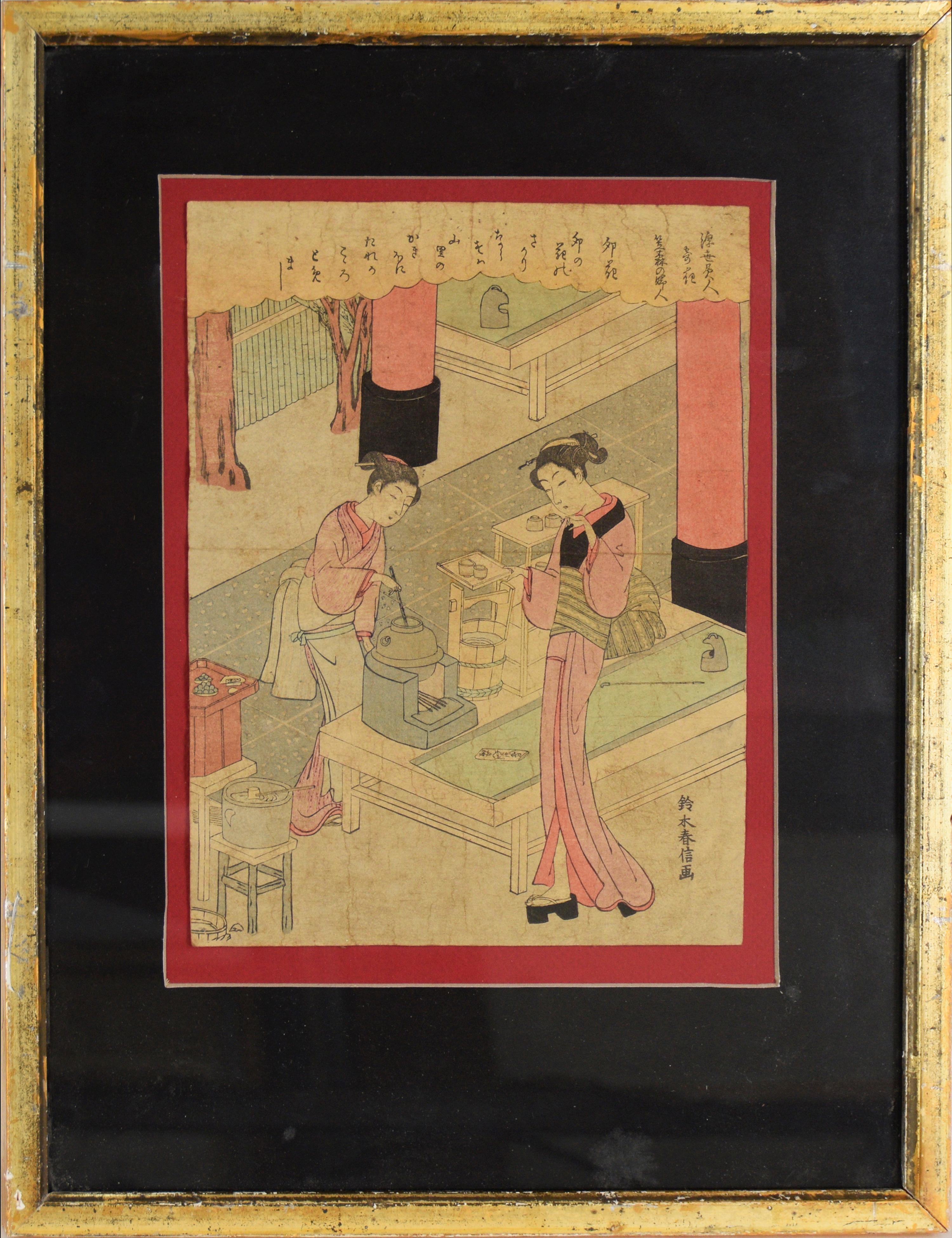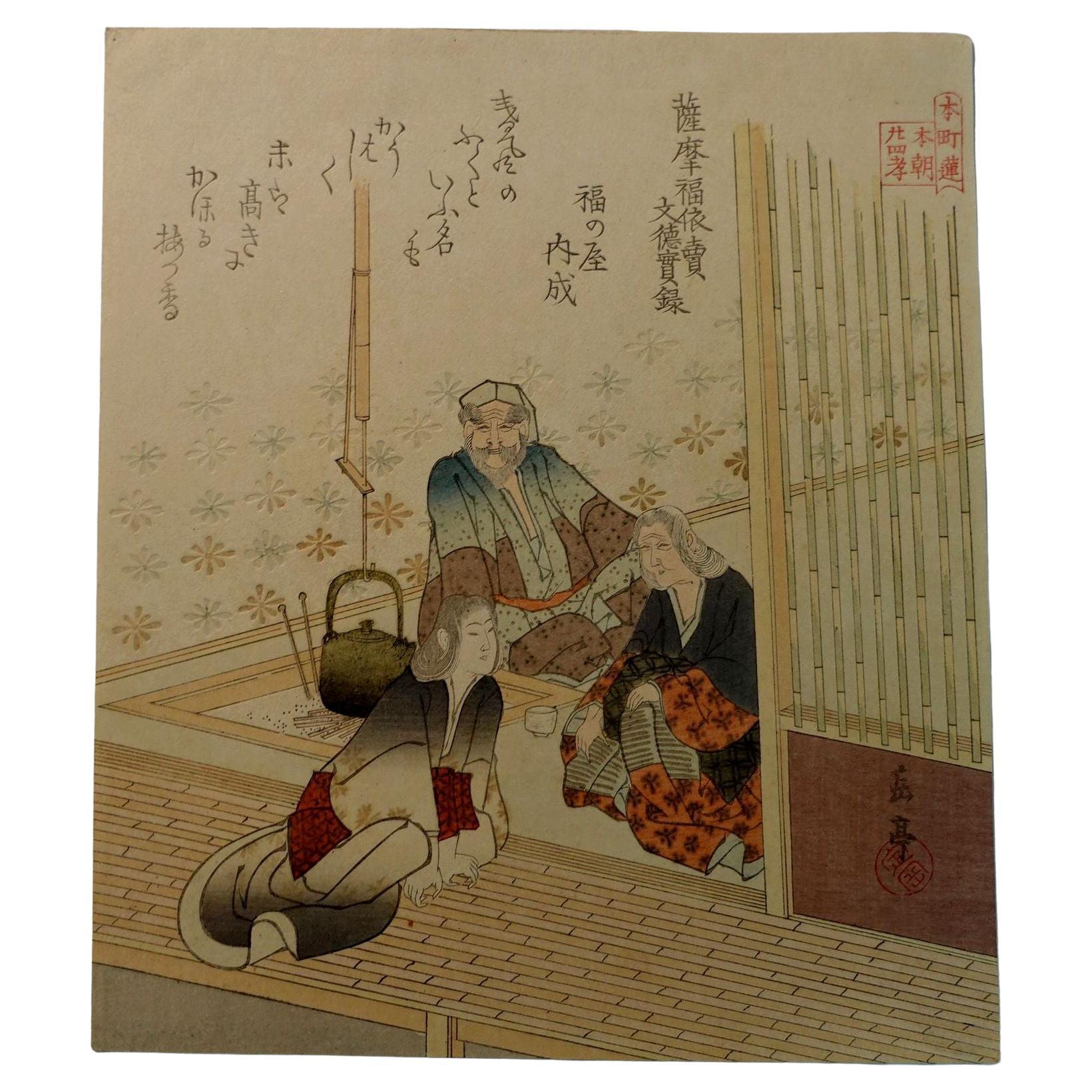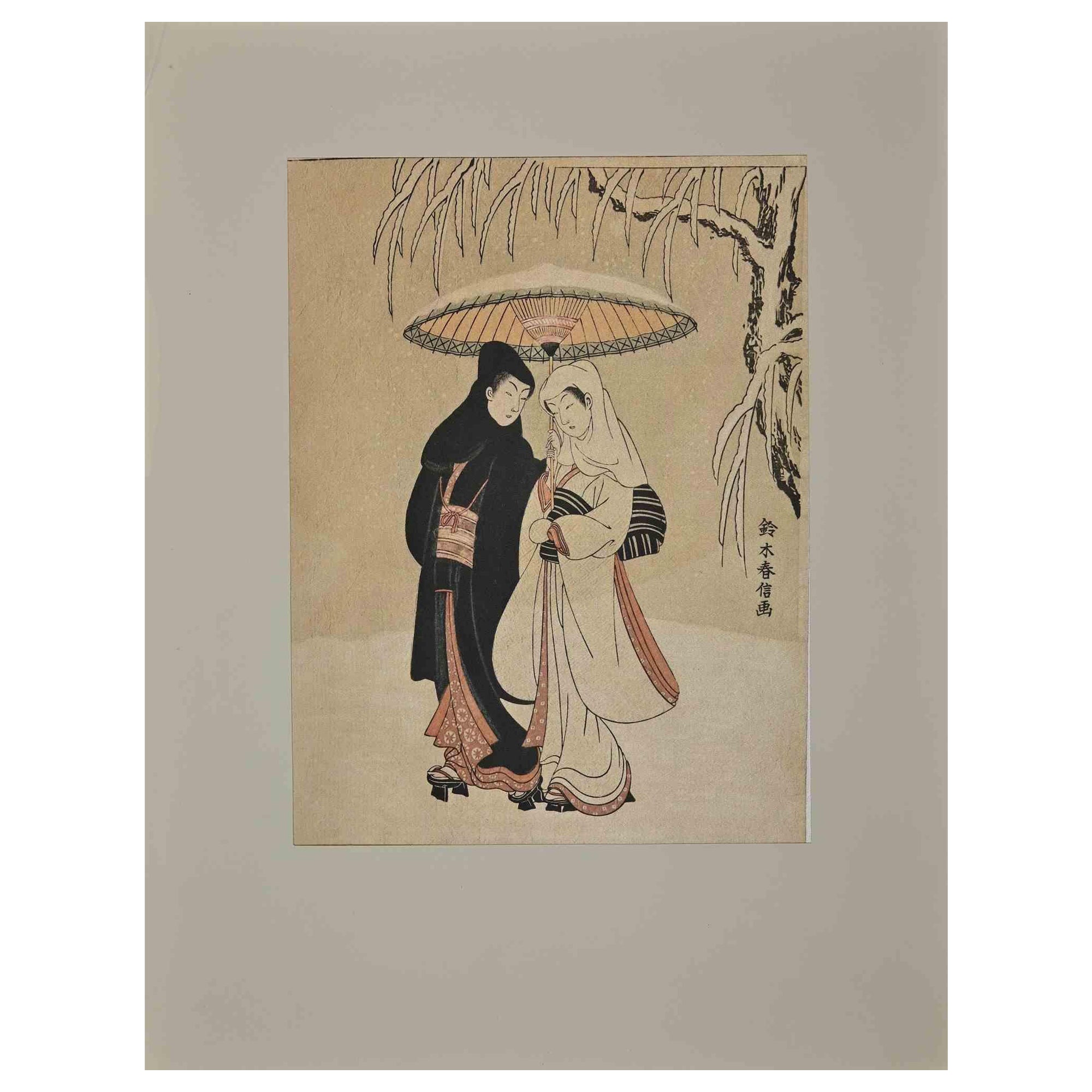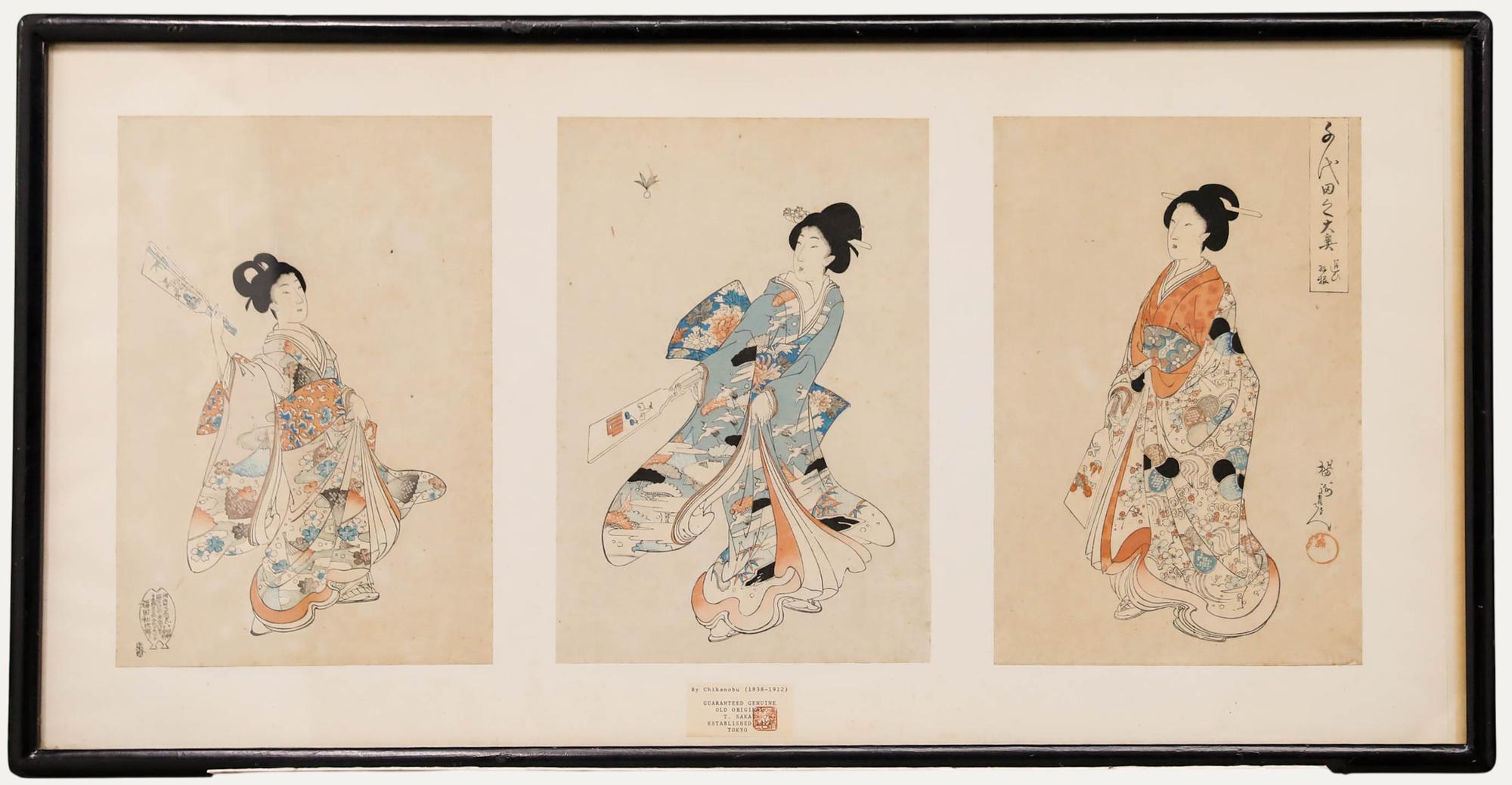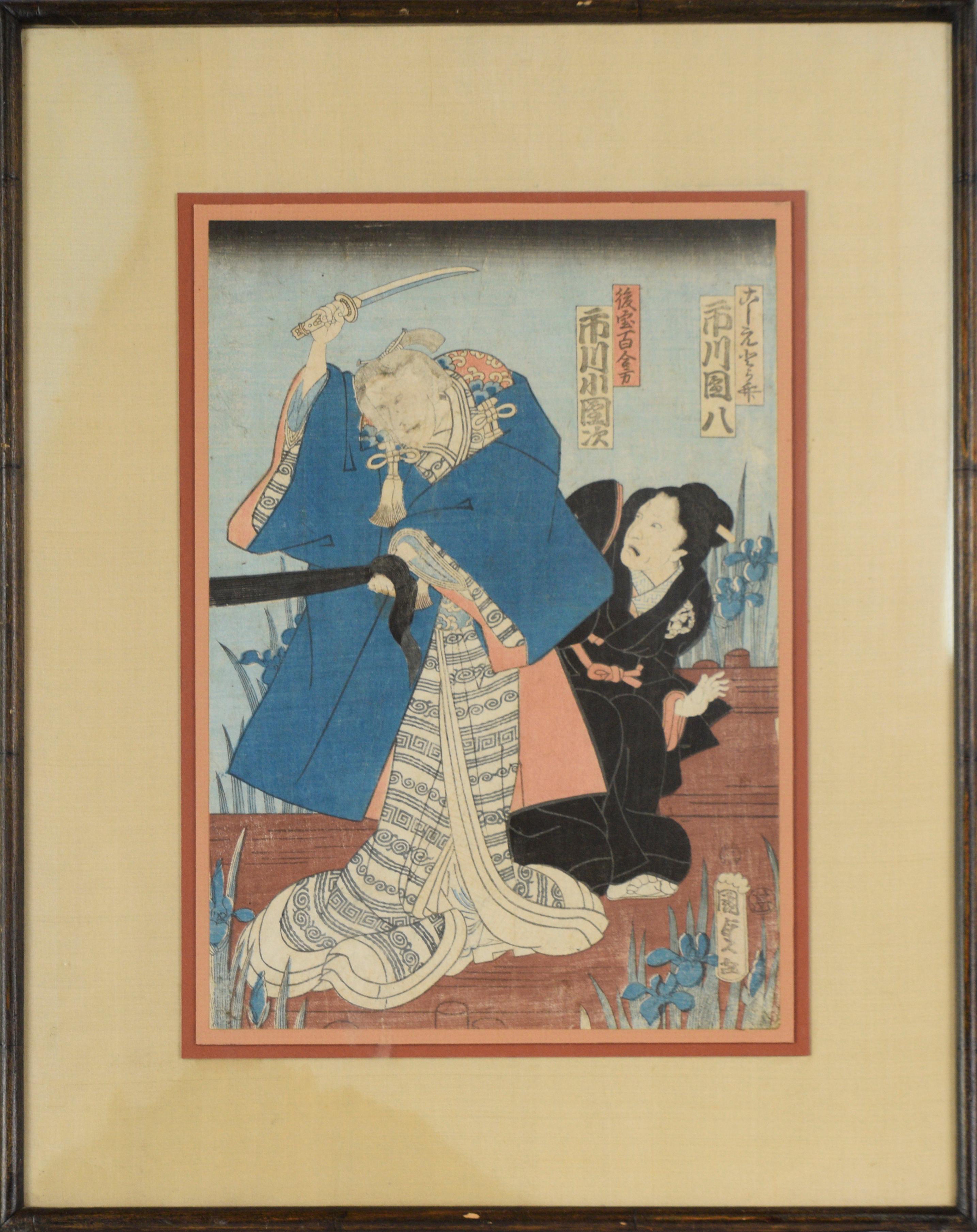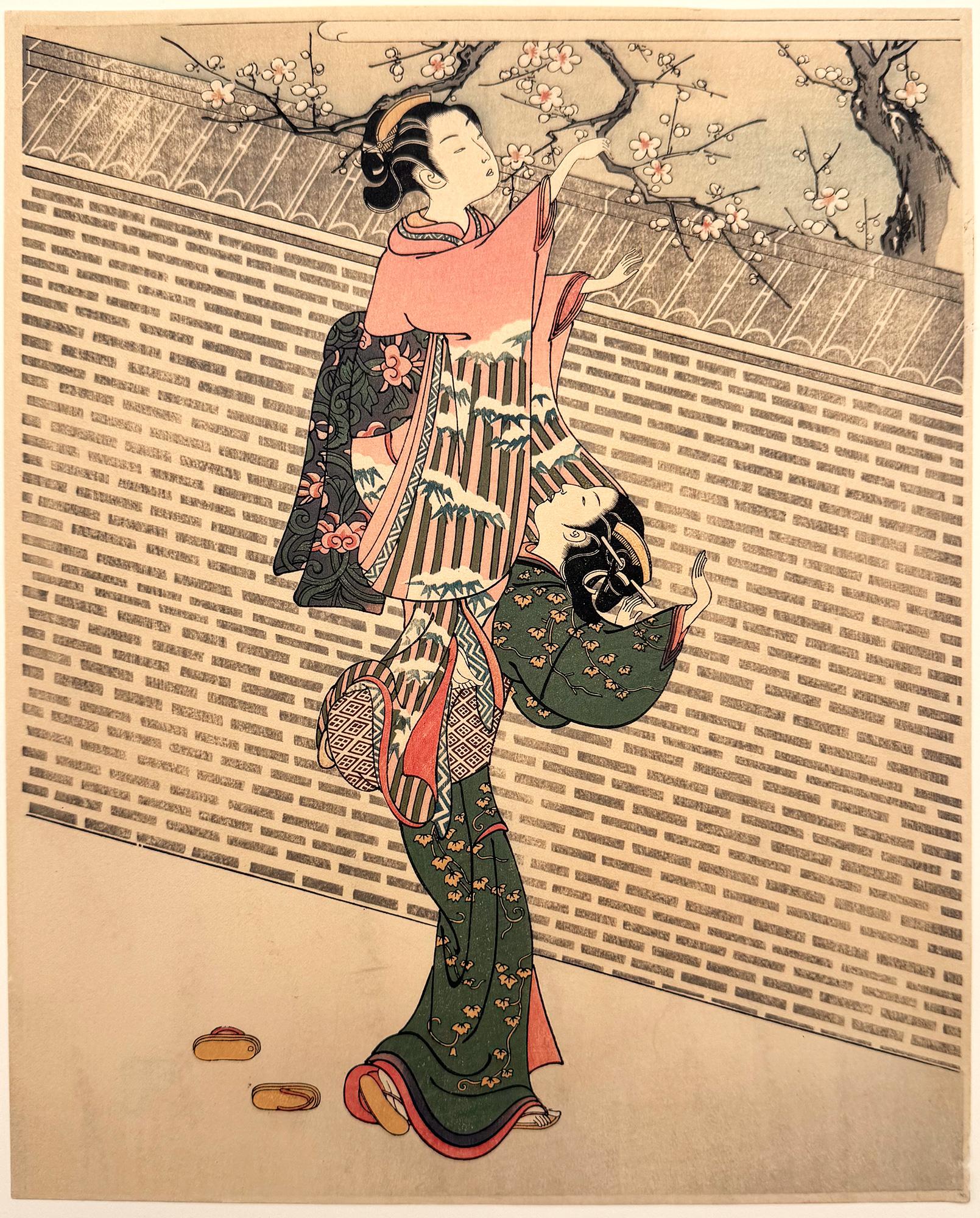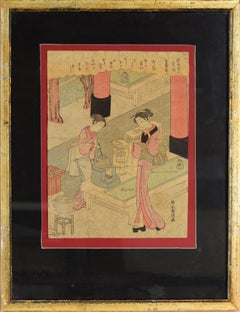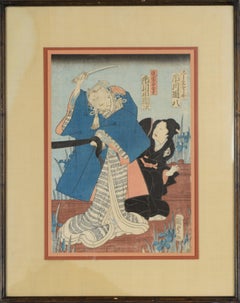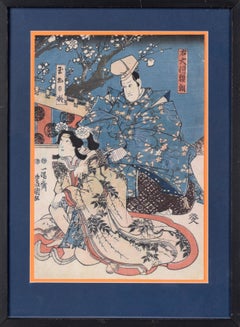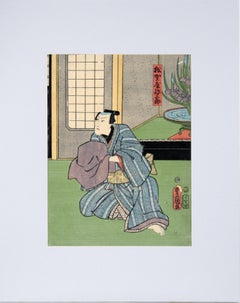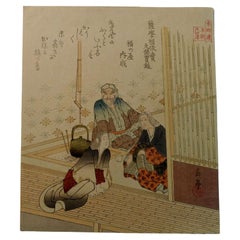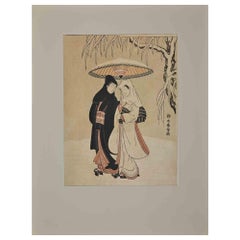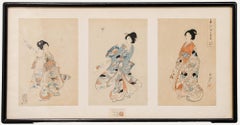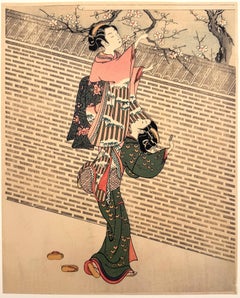Items Similar to Japanese Original Woodblock Print
Want more images or videos?
Request additional images or videos from the seller
1 of 10
Suzuki HarunobuJapanese Original Woodblock Print
$780
£596.56
€682.71
CA$1,110.15
A$1,201.97
CHF 639.03
MX$14,496.63
NOK 8,036.21
SEK 7,492.04
DKK 5,098.96
About the Item
Japanese Original Woodblock Print
Harunobu Suzuki (né Hozumi) (Japanese, 1724 - 1770)
Presented in a black mat.
Mat: 16"H x 12"W
Paper: 12"H x 9"W
Image: 11"H x 8 1/4"W
Harunobu Suzuki was one of the leading print artists of his time and is widely recognized as having played a major role in the development of nishiki-e, the polychrome print. He was born in Edo (today’s Tokyo), where he also worked for most of his life. The strongest influence during his early years came from the Kyoto master Sukenobu, along with Kiyomitsu, Toyonobu and the ukiyo-e painters of the Kawamata school. His study of the principles and methods of the Kano school and of 16th-century Chinese genre painters is also reflected in his work. Unlike most ukiyo-e artists, Harunobu used his real name rather than an artist name.
Harunobu is the archetypal painter of bijinga (prints of beautiful women) and his designs show ladies of the demi-monde, middle-class women going about their everyday tasks, and women in mythological scenes, all executed in elegant colour and well-differentiated technique. Other subjects from ordinary urban life in Edo such as street vendors and errand boys are also included in his artworks, while the themes are often humorous parodies. Harunobu also painted erotic scenes, and he liked to have celebrated contemporary beauties such as O-Sen and O-Fuji model for him.
In 1764 he was commissioned to design pictures for calendars, New Year’s and other congratulatory cards, so-called e-goyomi. Costly materials were used, and by 1765 the polychrome print was innovated by Harunobu through the use of multiple separate woodblocks in the creation of a single image. Instead of just two or three colours, the whole range of the artist’s palette was now available. The new technique depended on using kento (guide marks) to hold the paper in place and keep the successive colour printings in register. As such, Harunobu holds the credit for revolutionising printing in Japan and is much appreciated as an artist through the allegorical theme of his designs.
- Creator:Suzuki Harunobu
- Dimensions:Height: 16 in (40.64 cm)Width: 12 in (30.48 cm)Depth: 1 in (2.54 cm)
- Medium:
- Movement & Style:
- Period:
- Condition:Fair condition. Some tears around corners of paper, consistent with age.
- Gallery Location:Soquel, CA
- Reference Number:Seller: N96781stDibs: LU54215523512
About the Seller
5.0
Platinum Seller
Premium sellers with a 4.7+ rating and 24-hour response times
Established in 1986
1stDibs seller since 2014
3,049 sales on 1stDibs
Typical response time: <1 hour
- ShippingRetrieving quote...Shipping from: Soquel, CA
- Return Policy
More From This Seller
View AllDeutzia Flowers: The Wife of Kasamori - Original Woodblock Print
Located in Soquel, CA
Deutzia Flowers: The Wife of Kasamori - Original Woodblock Print
Deutzia Flowers: The Wife of Kasamori, from the Series "Beauties of the Floating World Associated with Flowers" by S...
Category
1760s Edo Figurative Prints
Materials
Woodcut, Ink, Rice Paper
$720 Sale Price
20% Off
Kabuki Actor in Blue Kimono - Original Woodblock Print
Located in Soquel, CA
Kabuki Actor in Blue Kimono - Original Woodblock Print
Original woodblock print depicting a Kabuki actor in a blue kimono by Suzuki Harunobu (Japanese, 1725-1770). The actor holds u...
Category
1760s Edo Figurative Prints
Materials
Ink, Rice Paper, Woodcut
$1,080 Sale Price
20% Off
Two Actors - Japanese Woodblock by Chikanobu Yoshu
By Toyohara Chikanobu
Located in Soquel, CA
Two Actors - Japanese Woodblock by Toyohara Chikanobu (豊原周延, 1838–1912), better known to his contemporaries as Yōshū Chikanobu (楊洲周延).
Colorful and expressive court scene. Two actors...
Category
1890s Edo Landscape Prints
Materials
Ink, Rice Paper, Woodcut
$700 Sale Price
20% Off
"Sun Saburo Matsugaya" - Mid 19th Century Figurative Japanese Woodblock Print
By Utagawa Kunisada (Toyokuni III)
Located in Soquel, CA
"Sun Saburo Matsugaya" - Mid 19th Century Figurative Japanese Woodblock Print
Beautiful mid 19th century figural Japanese woodblock print of a seated man with lilies in the background by Utagawa Toyokuni III (Kunisada) (Japanese, 1786-1864/5). Artist's chop is in the lower right corner of the piece. The actor is Magosaburo Matsugaya from the play "Katakiuchi Rumors"
Presented in a new grey-blue mat with foamcore backing.
Mat size: 21"H x 16"W
Paper size: 14"H x 9.75"W
During his lifetime Kunisada Utagawa...
Category
1850s Edo Figurative Prints
Materials
Paper, Ink, Woodcut
"Various Himochi" Wagashi Festival Japanese Woodblock Print by Utagawa Toyokuni
By Utagawa Toyokuni
Located in Soquel, CA
"Various Himochi" Wagashi Festival Japanese Woodblock Print by Utagawa Toyokuni
Rare oversized early 19th century 5-tiered woodblock by Utagawa Ichiyosai Toyokuni, (Japan, 1769-1825), a Japanese lord and wife oversee a sekku festival of food, music, and dolls or toys. '"oshi" is the first day of “Mi (Snake)” in the third month of the lunar calendar. This day, known in modern Japan as the Girls' Festival, originated in China as a form of purification ceremony in which water and drinking peach blossom wine were used to drive away evil. Many kinds of hishi-mochi appear in this picture of hina ningyo (dolls associated with Hinamatsuri, or the Girl’s Day) from Omochae.
The custom of eating special dishes at events throughout the year and at milestones in people's lives has existed since ancient times. This paragraph specifically focuses on the annual event called sekku, and life events that involve eating sweets. Joshi is the first day of “Mi (Snake)” in the third month of the lunar calendar. This day, known in modern Japan as the Girls' Festival, originated in China as a form of purification ceremony in which water and drinking peach blossom wine were used to drive away evil. According to the Keiso saijiki, in ancient China, on the third day of the third lunar month, people ate “ryuzetsuhan,” which is the juice of gogyo (Jersey cudweed) mixed with rice flour and nectar. In Japan, there is a record in the Heian period history book Nihon Montoku tenno jitsuroku [839-5] that it was an annual event to make kusamochi using gogyo on the third day of the third month of the lunar calendar, which may have been influenced by Chinese customs.
The tradition of eating kusamochi on the third day of the third month of the lunar calendar continued after that. By the Edo period, however, hishimochi had come to be used as a sweet to serve on the third day of the third month. A picture of a hishimochi is included in the Morisada manko , which we mentioned in Part 1. According to it, hishimochi in the Edo period were often three layers of green-white-green instead of the now common red-white-green. However, it is possible to see from our collection that not all hishimochi were made in this way. Omochae published in 1857, is a good example. Omochae is a type of ukiyoe print...
Category
1820s Edo Figurative Prints
Materials
Ink, Rice Paper, Woodcut
Annual Events for Young Murasaki (July) - Tales of Genji - Japanese Woodblock
By Utagawa Kunisada (Toyokuni III)
Located in Soquel, CA
Annual Events for Young Murasaki (July) - Tales of Genji - Japanese Woodblock
Rightmost panel a triptych, depicting monthly events for Wakamurasaki (Young Murasaki). This is the month of July. There appears to be a lesson taking place, possibly for writing or poetry.
Artist: Toyokuni III/Kunisada (1786 - 1864)
Publisher: Ebisu-ya Shoshichist
Presented in a new blue mat.
Mat size: 19"H x 13"W
Paper size: 14.5"H x 10"W
Commentary on the triptych:
In the Edo period, Tanabata was designated as one of the five seasonal festivals, and became an annual event for the imperial court, aristocrats, and samurai families, and gradually came to be celebrated by the general public. Its origins are said to be a combination of the Kikoden festival, which originated from the Chinese legend of Altair and the Weaver Girl, and Japan's ancient Tanabata women's faith. Ink is ground with dew that has accumulated on potato leaves, poems and wishes are written on five colored strips of paper, which are then hung on bamboo branches to celebrate the two stars that meet once a year. Although the illustration is a Genji painting...
Category
1850s Realist Figurative Prints
Materials
Printer's Ink, Rice Paper, Woodcut
You May Also Like
Japanese Woodblock Gakutei by Harunobu Sugawara-2
Located in Norton, MA
Japanese Woodblock Gakutei (1786-1868) by Harunobu Sugawara, original and unframed.
About the artist
Born in Edo as Harunobu Sugawara, Gakutei Yashima studied printmaking under Shuei and Hokkei. He moved to Osaka in the 1830s, where he designed landscape studies of his new home with a delicate and decorative style likely influenced by Hokusai. In addition to printmaking, he wrote Kyoka (comic poems), often illustrating these verses in his prints. While a talented woodblock artist, Gakutei was also known throughout Japan as a writer. He translated and illustrated the 16th-century Chinese novel Journey to the West...
Category
Antique Early 19th Century Japanese Prints
Materials
Paper
Lovers - Woodcut after Suzuki Harunobu - Mid-20th Century
Located in Roma, IT
Lovers Walking in the Snow is a woodcut print realized in the mid-20th Century after a woodcut print by Suzuki Harunobu.
Good conditions.
The artwork is depicted through soft line...
Category
Mid-20th Century Modern Figurative Prints
Materials
Woodcut
Toyohara Chikanobu (1838–1912) - Japanese Woodblock, A Game of Hanetsuki
By Toyohara Chikanobu
Located in Corsham, GB
A delightful triptych by the artist Toyohara Chikanobu (1838–1912), depicting ladies playing a game of Hanetsuki – a traditional Japanese game, similar to badminton but played with a...
Category
19th Century Figurative Prints
Materials
Woodcut
Plucking a Branch from a Neighbor's Plum Tree
By Suzuki (Hozumi) Harunobu
Located in Middletown, NY
A mischievous tableau with sexual overtones.
Tokyo: Shuei-Sha, 1768.
Woodblock print in colors printed on laid mulberry paper, 10 3/4 x 7 7/8 inches (273 x 200 mm), full margins. I...
Category
Mid-18th Century Edo Portrait Prints
Materials
Watercolor, Handmade Paper, Woodcut
The Flowering Daigo - Woodcut by Toyohara Chikanobu - 1885
By Toyohara Chikanobu
Located in Roma, IT
The Flowering Daigo is an original artwork realized in 1885 by Toyohara Chikanobu (1838–1912).
Limited edition woodcut print signed on plate.
From the series "Setsu gekka", (Snow, ...
Category
1880s Modern Figurative Prints
Materials
Woodcut
$525 Sale Price
35% Off
Japanese Color Woodblock Print by Toyohara Chikanobu
By Toyohara Chikanobu
Located in New York, NY
This Meiji-period color woodblock by Toyohara Chikanobu (1838-1912) depicts three elegant female courtiers in traditional dress taking refreshments. Th...
Category
Antique Late 19th Century Japanese Meiji Prints
Materials
Paper
